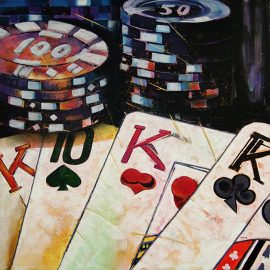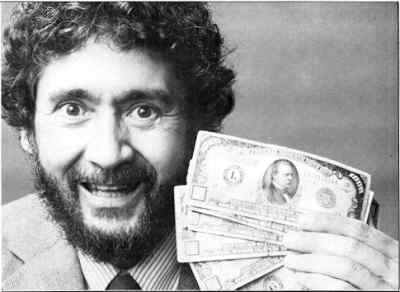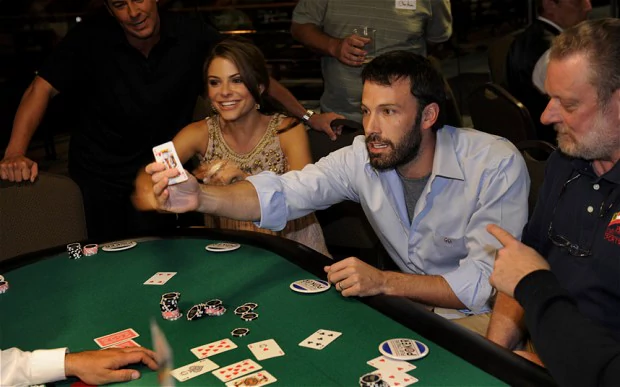As Caravaggio prepared his arsenal of brushes and colors, inky lights and bright shadows, fighting cheats and unworldly gamblers, the Italian unruly painter was actually promoting the first street casinos to future generations of artists. The canvas was thus laid bare for the birth of gambling art.
In time, this low-status activity that Caravaggio popularized within the world of well-heeled arts did not escape the ideological sympathies of one or the other.
There were artists who recognized the intellectual ambitions of a game of poker and who engaged in gambling themselves as in a harmless form of amusement. But they remain a rare breed.
The dark side of gambling shines stronger. Down the historical gallery of paintings depicting games of chance, tossing the dice comes out looking like one messy affair.
It's the moral disease of low-class squandrels and upper-crust rich decadents. It becomes the favorite playground of cartoonists. It finds itself at the tip of the inquisitorial finger.
And it bleeds at the stroke of a William Hogarth's pen, with gamblers ending up bullied by a moralistic history.
Nevertheless, games carry a particular flavor of eye-candy. Below runs a graphic timeline of the many faces gambling has adopted throughout the ages.
Take a pause from the pokies or that high-rolling bet on the poker table to walk through an online exhibition of gambling art.
Blue Chip Art – Gambling As Seen On The Canvas Of History
Andrea Mantegna, The Crucifixion- 1457
Gambling dates from 4,500 years ago. Back then, gamers could do all sorts of antics without drawing the heavy criticism of painters.
When a disrespectful group of Roman soldiers tossed the dice for the clothes of Jesus Christ whilst the son of God was breathing his last prayer for mankind, artists did not demonize the act.
“Let’s not tear it,” they said to one another. “Let’s decide by lot who will get it.” This happened that the scripture might be fulfilled which said, “They divided my garments among them and cast lots for my clothing.” So this is what the soldiers did.
How God's will was to be read in the provident tossing of the dice, read here. Or, for a more in-depth documentation, dust off your Old Testament.
Michelangelo Merisi da Caravaggio, The Cardsharps- 1594
Caravaggio had an eye for seeing things to their core, behind flimsy appearances. The Cardsharps was the second painting the artist created as an independent freelancer, and the theme dwells closer to the painter's interests.
Vice and gambling, violence and deceit. Nowadays, the casino dealer couldn't tuck those extra cards behind his back and a dagger on his belt whilst the security guard would peer over your shoulder and frantically signal his accomplice that you're bluffing.
On the contrary, casinos employ much more unbeatable, legal tactics that work on a psychological ground to lure gamblers to their slot machines and green table games.
Georges de la Tour, The Cheat with the Ace of Diamonds- 1635
From the cave design of the casino where no clocks or windows exist to the labyrinthine execution of the interior architecture so the gambler would lose track of the exit gate, land-based gambling venues follow the logic of the department stores to keep its clients aimlessly wandering through its menu of games.
Pieter Quast, Soldiers Gambling with Dice- 1643
Gambling remained an activity of ill repute throughout the aggressive enforcement of Catholic doctrine over the European lifestyle.
Dutch painters in the 1600s were like the rockstars of the Woodstock era. Everyone wanted a piece of them.
They were visually outspoken, ruthlessly pointed to the delicious vices of their society, and many lived fast and died young, some brought down by financial ruin, others at the hands of more conservative factions.
Like many of his guild brethren, Pieter Quast died in poverty. But his paintings and satirical sketches endure centuries later, in the world of gambling and outside it.
Venetian School, Gambling at the Ridotto during the Carnival- Around 1700
Italians measure their days out in espresso cups- and, a lesser known fact, in lottery tickets. The peninsula in southern Europe, the world’s fourth-largest gambling market, is rife with Caesar's Palaces as much as with ancient Roman ruins.
You never wondered where the term “casino” comes from?
As Florence outlawed gambling in the 13th century, the grandees belonging to the upper-class needed to vent their appetite for games of chance somewhere away from the eyes of authorities.
Casini was a small-sized and hidden abode where the rich gathered to play biribi and bassetta, the former a lottery game and the latter an Italian version of baccarat.
Much like India is planning to legalise gambling in the light of a blindingly clear nationwide appeal to online casino games, Italy changed its dictatorial ways in the 17th century.
The administrators of Venice decided in 1638 to open the first government-owned, mercantile and legal gambling venue.
The Ridotto (the term for a private room), an appendix to the Palazzo Dandolo until then, metamorphosed into a burlesque prototype of today's casino.
In accordance to the Venetian spirit of masquerade and funfair, gamblers were required to wear masks and three-cornered hats to gain entry into the Ridotto.
Pockets heavy with golden scudis and egos bulky with the recent gain, high-rollers would walk out of the Palazzo straight into the mouth of the predatory network of thieves running alongside the canals.
After the state of Venice wolfed down the remaining revenue of the first casino, they closed the Ridotto on moral ground in 1774.
The Italian government wouldn't revise its firm stance against gambling until late 2006 when the European Commision insisted the peninsula got over its past traumas and accept reality.
Italians simply love to toss the dice, even when they lose up to $17,5 billion a year.
William Hogarth, A Rake's Progress- 1732
Image Description: The spendthrift Tom Rakewell in a gambling den at Soho's White Club in London.
Gambling is normally depicted in a more or less negative context. Its dual reputation as not only an individual vice but also a social moral transgression was firmly ingrained in the mainstream British thinking by the late 18th century.
The middle-class, an emergent layer built on sand in the new society, felt particularly sour toward the excesses of the old aristocrats.
Although games like faro, ace of hearts, basset, roly-poly, and hazard were being gradually outlawed by the end of the 18th century (some, never re-entering public grace again, are extinct today), the rich would still indulge in massive gaming parties.
However, if you belonged to the inferior category of wives and ladies of wealth, your reputation would be tarnished beyond the redeeming power of money.
Such was the case of the Faro Ladies.
James Gillray, Faro Ladies- 1800
The bourgeois always looking for an opportunity to lambast the landed classes, the press couldn't simply deny them delicious gossip that a group of women of the upper echelon were hosting private gambling gatherings in their homes.
According to King George III “Proclamation against Vice”, gambling posed a threat to the well-being of a society. And it had to be eliminated. The scapegoat group to take all the negative media attention upon themselves were the Faro Ladies.
As seen in the unmerciful sketches of James Gillray and William Hogarth, two of the most famous caricaturists and printmakers in the history of the industry, society demanded that the transgressors of King George III's ban be publicly humiliated in the pillory.
The Faro Ladies used up all their high-ranking influence to escape penalty with just a fine.
In the 1800s, The Morning Post announced:
Society has reason to rejoice in the complete downfall of the Faro Dames, who were so long the disgrace of human nature. Their die is cast and their old tricks no longer avail.
William Robinson Leigh, The Gambler- 1892
A quiet revolution in the art of gambling took place when games of chance crossed the midlands of the American continent into the Wild West. The vastness of the desert and the high-risks involved in a life lived within the blast of gunslingers and shootouts dwarfed the perils of a classic gambling set.
Gambling became apple pie American, New World-approved. It was no longer the pursuit of the upper-class. The frontier gambler became a more captivating myth than the faro ladies.
The bar casinos- the early prototypes not more than “a board stretched between two whiskey barrels, a rickety table, a few chairs and a greasy, dog-eared deck of cards”- made appropriate bedfellows with the bustle of the gold rush.
Quarrels happened all the time, and Texas Holdem and vingt-et-un (twenty-one, the ancestor of blackjack) brought many gambling addicts to their knees, financially ruined or otherwise socially discredited. Unless you were a maverick, of course
To its credit, though, the art of gambling also became the great gender and rase equalizer. Madame Mustache, Poker Alice, and Kitty LeRoy rose through the ranks of legendary gamblers, despite they're being women.
You'll never see a more democratic cross-section of gamblers until the casino liberalization process kicks down the moral and religious restriction in the 1980s.
Otto Dix, War Veterans playing cards- 1920
Otto Dix, not a particular lover of the excesses of the Weimar period or the cruelties of WWII, painted gambling in harsh brush strokes. Ironically enough, the savage satirist belonged to the wave of New Objectivity. He missed a bit of that, we'd say.
Cassius Marcellus Coolidge, Dogs Playing Poker- 1903
Who let the dogs out? An old anonymous painter, as it turns out.
In the proud American tradition of launching the modern-day salesmanship tactics and initiating the madness of global PR, Coolidge started his series on Dogs Playing Poker as an advertising strategy for cigar boxes.
The artist was 59 years old at the time. Later on, a New York Times contributor tried to explain the lure and sexual politics behind Coolidge's works and why his paintings turned out to be such an enduring global phenomenon.
Men drink, bellow, smoke and play poker. The women who serve them … their game is too tame the bad boys.
A man's best friend... is not a gambling dog when the chips fall down, apparently.
LeRoy Neiman,
In his serigraph Baccarat, LeRoy Neiman studied the game in progress, the drama of the well-heeled poker sharks and the noiseless interaction between gamblers at an American casino.
The painter resurrected art in gambling and adopted the bird's eye view to absorb the dramatic, but energetic mood of a big payoff in a baccarat game.
Casino Art Will Live Long and Die Hard
Take your pick of the many faces of gambling. It's one of the oldest trades in human history, a coin you can toss in the air without worrying about the odds. Games of chance will ride the timeline, be it heads or tails. And artists will be there to capture all of its sides, angles, and colorful odors.
Be it as addiction or sin, hobby or entertainment, a sweet vice or a financial corset, Native American restitution or Italian frenzy, mafia business or legitimate royal past time, a man's luck or a dog's chance, gambling in art endures.



















